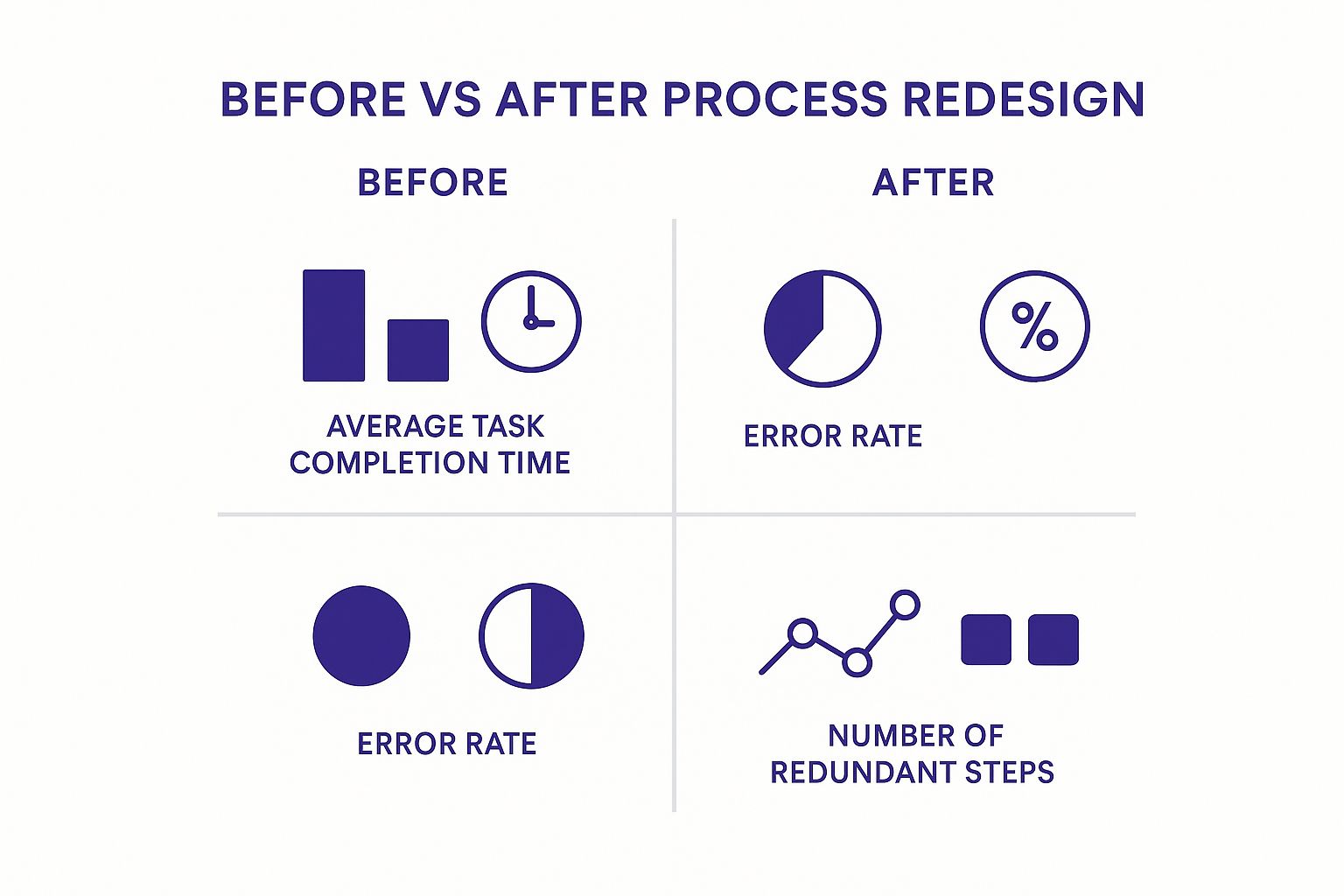Boosting team productivity isn't about just buying the latest software. It's about building an environment where people can do their best work without friction. The real magic happens when you nail three things: clear goals, smart processes, and genuinely engaged employees. When you get these fundamentals right, you stop counting hours and start seeing incredible results.

Before you start looking at new tools or tactics, let's get one thing straight: real productivity is a side effect of a healthy team culture, not a set of rules you impose. It grows from a foundation of trust, clarity, and a sense of shared purpose. When people know why their work matters, they bring a whole different level of energy to the table.
The classic mistake I see leaders make is jumping on quick fixes—a new app, a trendy management fad—without looking at what's really broken. These band-aid solutions almost always fall flat because they don’t fix the root causes, like disengagement or clunky workflows.
If there's one "secret sauce" to team productivity, it's employee engagement. A disengaged person is just punching the clock. But an engaged team member? They're actively looking for ways to make things better, not just for themselves but for everyone.
The data tells a stark story. In 2024, only about 21% of employees worldwide were truly engaged with their work. This isn't just a morale problem; it's a massive financial drain. Gallup calculated that this widespread disengagement costs companies a staggering $438 billion in lost productivity every year.
This points to a simple truth: you can't force people to be productive. You have to create the conditions where they want to be. That all starts with making sure your team feels valued, heard, and connected to the mission.
Key Takeaway: A productive team is an engaged team. Investing in your people, fostering a supportive culture, and ensuring clear communication will always deliver a higher return than simply demanding more output.
Building a productive team is about more than just hiring smart people. It's about designing a system where their talents can shine. To do that, you need to understand how to build high-performing teams from the ground up.
The table below breaks down the foundational elements that every high-performing team needs to have in place.
Without these pillars firmly in place, any new tool or productivity hack you introduce is just a temporary fix. True, sustainable productivity starts here.
Bad processes are a quiet drain on your team's energy and focus. They create this constant, low-level friction, where people spend more mental energy fighting the system than doing the work they were hired for. The first step to fixing this isn't to guess what's wrong—it's to make the invisible visible.
This is where workflow mapping becomes so valuable. It’s a straightforward but incredibly insightful exercise where you draw out a process from the very first step to the last. Think of it as creating a blueprint of how work actually gets done, not how you think it gets done. When you lay it all out, the redundancies, the pointless handoffs, and the frustrating bottlenecks become glaringly obvious.
I saw this with a marketing team I worked with. They mapped their content creation process and were shocked to find a single blog post went through seven different approval stages before it could go live. Turns out, three of those stages were completely redundant. By simply consolidating the approvals, they cut their time-to-publish in half.
Once you've mapped out the messy reality, the real work begins: designing a cleaner, more direct path forward. This isn't about blowing everything up and starting from scratch. It's about finding the small, smart changes that deliver the biggest results.
Get your team in a room (or on a call) and ask some direct questions:
When you pull your team into this process, you get more than just good ideas. You get buy-in. It stops being a mandate from on high and becomes a shared mission to make everyone's work life a little bit easier.
A well-designed workflow makes the right way to do things the easiest way. When the path of least resistance leads to high-quality work, you’ve created a system that naturally fosters efficiency.
The impact isn't just theoretical. Look at the kind of improvements you can expect when you untangle a convoluted process.

As you can see, a streamlined workflow isn't just a "nice-to-have." It directly leads to getting things done faster, with fewer mistakes and a lot less wasted effort.
The final piece of this puzzle is making the new process stick. Once you've ironed out the kinks, you need to document it. I’m not talking about a 50-page manual no one will ever read.
Simple checklists, templates in your project management tool, or a clear guide in a shared space like Notion or Confluence is all it takes. The goal is to create a single source of truth so that quality and consistency are built-in, no matter who's doing the task. It removes ambiguity and empowers everyone to follow the same high-efficiency playbook.
Technology should be a force multiplier for your team, not another source of friction. I've seen it happen countless times: a company adopts a dozen new tools, but instead of boosting output, they create a clunky, disconnected system that just gets in the way. The goal isn't to have the most apps; it's to build a smart, cohesive tech stack where every tool has a purpose and makes life easier.
Think of your tools as a single ecosystem. Do they work together seamlessly? Or is your team constantly stuck copying and pasting information between a project management app and your chat platform? True productivity comes from integration, not from having more logins to manage.
Building an effective tech stack means getting the fundamentals right. While your specific choices will depend on your team's needs, most high-performing teams rely on a solid foundation covering a few key areas.
Getting your collaboration tools right is one of the most impactful things you can do, especially with remote or hybrid teams. For a deeper look at the options, this guide on Top Remote Team Collaboration Tools is a great resource.
To help visualize how these pieces fit together, I've put together a simple table comparing the different categories of tools and where they shine. This can help you spot gaps in your current setup.
Choosing the right tool in each category helps ensure you have a balanced stack that supports your team instead of holding them back.
Let's be honest: repetitive, low-value tasks are an absolute killer of momentum and morale. Every hour your team spends on manual data entry or sending the same follow-up emails is an hour they aren't spending on creative problem-solving or talking to customers. This is where automation has become a game-changer.
AI agents, in particular, offer a massive opportunity. A platform like Upcraft lets you deploy smart, conversational AI to handle those routine interactions for you. Think about it: an AI agent can follow up with old leads, answer common customer questions, or even schedule demos, all on its own. It's not about replacing your team; it's about augmenting them—giving them the freedom to focus on the work that truly requires a human touch.
Key Insight: Don't just automate for the sake of it. Find the most boring, mind-numbing, and repetitive tasks in your team's workflow. Target those first. The real win is giving people back their most valuable asset: time.
Here’s a perfect example of what this looks like in practice. You can configure an agent to handle a very specific, time-sucking job.
This screenshot shows just how granular you can get. You can define an agent's exact purpose, whether that's re-engaging a cold lead list or booking meetings. What was once a manual, multi-hour process becomes a completely automated workflow. By offloading this kind of work to technology, you're directly increasing your team's capacity to do more meaningful, strategic work. This is how you make a real, tangible impact on productivity.

You can have the most dialed-in workflow on the planet, but if your team's culture is toxic, it’s all for nothing. Productivity isn't just about software and systems; it’s a deeply human thing. It really only takes root when people feel secure, see their purpose, and can genuinely trust their leaders and teammates.
Without that foundation, you don't get action—you get hesitation. People get too scared to ask for help, admit they messed up, or throw a bold idea on the table. This is why fostering a culture built on clarity and psychological safety is one of the most direct routes to unlocking your team's long-term potential.
Ambiguity is productivity's worst enemy. When your team isn’t sure what the real priorities are, they burn a ton of mental energy just trying to guess what you want. This is exactly where goal-setting frameworks like Objectives and Key Results (OKRs) can be a game-changer.
OKRs draw a straight line from someone's day-to-day work all the way up to the company's biggest ambitions. A software developer can see exactly how their work on a specific feature (a Key Result) directly contributes to the company's bigger goal of boosting user engagement (the Objective).
When people understand the "why" behind their work, their mindset shifts from just checking off tasks to driving real outcomes. That simple change is a huge catalyst for proactive, independent work.
This kind of clarity does more than just sharpen focus; it empowers people to be autonomous. When everyone knows where the team is headed, you don't have to micromanage how they get there.
Real trust isn't built in some grand, sweeping gesture. It’s forged in the small, consistent, and honest conversations that happen over time. To get there, you need to deliberately create channels where feedback can flow in every direction—not just from the top down.
These regular touchpoints build a rhythm of communication, making feedback feel normal and helpful, not scary and confrontational.
Psychological safety is simply an environment where people feel safe enough to be vulnerable. It's a place where someone can say, "I'm not sure how to do this," or "I made a mistake," without fearing they'll be shamed or punished. For any team that needs to innovate or solve hard problems, this is non-negotiable.
Think about a development team that finds a critical bug. In a culture of fear, the person who caused it might try to hide it, making the problem exponentially worse. In a psychologically safe culture, they raise the alarm immediately. The team then swarms the problem, fixes it, and learns from the experience together.
Fostering this kind of safety starts at the top. When leaders openly admit their own mistakes and uncertainties, it gives everyone else permission to be human, too. That trust is the ultimate fuel for a team that isn't just productive but also resilient and genuinely creative.

Let's be real: time management isn't just a personal skill anymore. It has to be a team sport. You can have the most dialed-in workflow on the planet, but if your team is constantly getting pulled in a dozen different directions, none of it matters. The goal is to build a collective shield against distractions so deep work can actually get done.
The modern office is basically an interruption factory. It’s not just a feeling; a study found that the average office worker gets interrupted every 11 minutes. Even worse, it can take over 20 minutes to get back into a state of deep focus after each one. That constant context-switching is a massive productivity killer.
One of the most effective ways I've seen teams fight back is with time blocking. This isn't about micromanaging calendars. It's about collectively agreeing on sacred, uninterrupted blocks of time where everyone can just put their heads down and work.
For example, a marketing team might set a "Creative Focus Time" from 9 AM to 11 AM every single day. During that window, there are no internal meetings, and non-urgent Slack pings are off the table. This simple pact gives everyone the permission they need to ignore the noise and dive into their most important work.
Key Takeaway: Protecting focus is a shared responsibility. When the whole team agrees to respect certain time blocks, deep work becomes the default, not the exception.
Beyond dedicated focus time, you need a game plan for the daily onslaught of pings, dings, and emails. It’s all about creating clear ground rules that respect everyone’s time and attention.
Here are a few practical agreements that make a huge difference:
These might feel like small tweaks, but their cumulative impact is huge. By creating a more predictable environment with fewer random interruptions, you give your team the space they need to reclaim their focus, produce higher-quality work, and feel less stressed while doing it.
Even with a solid plan, you're bound to run into a few questions when you start overhauling your team's productivity. Let's tackle some of the most common ones I hear from leaders trying to make these changes stick.
If you want a quick win, focus on two things: clarity and friction.
First, make sure every single person on your team knows exactly what their top priorities are for the week. No ambiguity. This simple act of alignment is often the biggest lever you can pull to stop people from spinning their wheels on tasks that just don't matter.
Next, talk to your team. Ask them: "What's the most annoying, repetitive, or clunky part of your day?" Identify one or two of those bottlenecks—maybe it’s a convoluted approval process or a manual report that eats up an hour every morning. Fixing those small, universally hated problems sends a powerful message and builds immediate momentum.
This is a big one. The trick is to shift your focus from activity to outcomes. Don't be the manager who counts keystrokes or obsesses over green status bubbles. Instead, measure what actually moves the needle. Are we hitting our project milestones? Is our customer ticket resolution time going down? Are sales numbers climbing?
A productive team isn’t just a busy team; it’s an effective one. Focus on the results they deliver, not the flurry of motion it took to get there. Trust them to manage their time and hold them accountable for what they accomplish.
This is where project management tools come in handy. You can track things like project velocity or task completion rates without breathing down anyone's neck. Combine that data with regular, informal check-ins focused on progress and roadblocks. This builds trust and ownership, which are far more powerful motivators than any micromanagement tactic.
Oh, absolutely. I’ve seen it happen more times than I can count. A new tool, introduced with the best of intentions, can easily become an anchor if it’s rolled out poorly. You end up with "tool fatigue," where everyone is juggling too many apps that don't talk to each other.
To make sure your new tech helps instead of hinders, you have to be deliberate.
Remember, the goal is for the tool to serve the team, not the other way around. A thoughtful approach turns technology into a true productivity booster.
Ready to reclaim your team's most valuable asset—time? Upcraft deploys intelligent AI agents to automate routine follow-ups, answer common questions, and schedule meetings, freeing your team to focus on high-impact work. Discover how you can boost your team’s capacity at https://www.upcraft.ai.
Enter your contact information and Archer will start a conversation with you via text message.